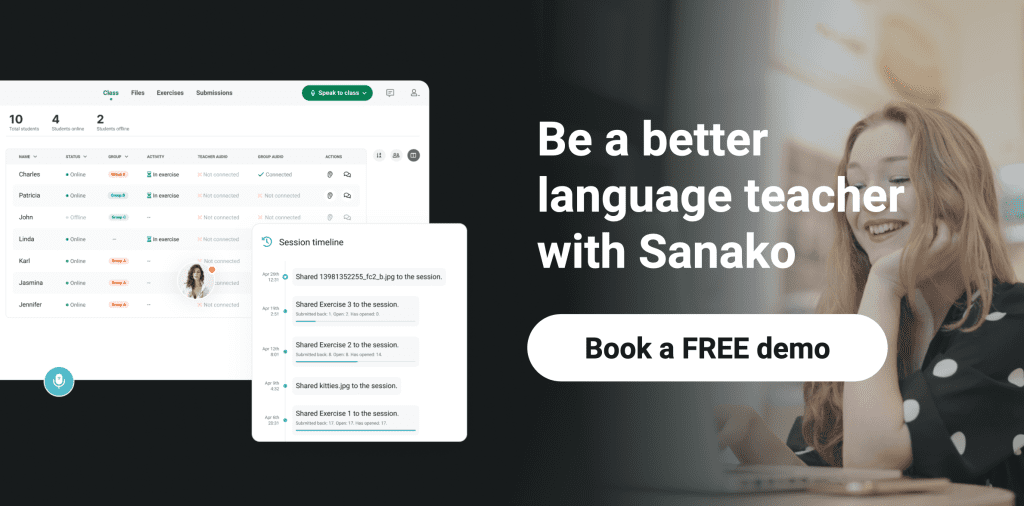One of the biggest challenges facing language educators is ensuring that their lesson plans and language teaching activities are closely mapped to students’ abilities and to their age. There’s clearly major differences in teaching an additional language to young children as compared to teenagers and adults. So how can language educators create best-in-class lessons for their students of different ages?
In broad terms, children are invariably full of energy and have short attention spans, so classes need to be fast-paced and include lots of fun games and activities. Teaching adults is no less challenging but tends to require a more detailed grammar-heavy knowledge base and it can often take longer for students to pick up key concepts. So this blog post looks at what it’s like to teach language learners of different ages and aims to provide some tips and tricks for delivering successful lessons.
We focus on four main groups of learners:
- Preschool (from 3 – 5 years of age)
- Elementary / Primary School (6 – 12 years)
- High School Learners (13 – 17 years) and
- Adult Learners (18+ years).
Preschool language learners
Young children usually don’t have a driving motivation to learn a new language and may even still be getting to grips with their mother tongue. But their wider interest in learning is usually driven by their innate curiosity and imagination. Delivering preschool language classes can be challenging given students’ shorter attention spans – teaching the youngest language learners does require large amounts of patience as well as strong classroom management skills to hold their attention at all times! Teachers and their lessons also need a high level of energy to be really engaging and successful.
It’s vital to ensure that students are kept active, busy and entertained, so lessons need to be jam-packed with material that keeps them on task. Movement is vital and that applies to the teachers as well as the students. Bringing words, ideas and stories to life by acting them out helps younger learners feel more confident in the classroom and powerfully conveys key learning objectives.
- Be clear and simple in your communication. Students will disengage if your instructions are too long and full of waffle
- Have fun and make it fun for the children too
- Total Physical Response (TPR) is your friend. Develop activities through which learners can produce the language through physical actions – stand up, sit down, stand by the window etc.
- Use the whole classroom environment to your advantage – learning can take place indoors, outside, sitting down, standing up or running around!
- Have prompts and gimmicks like puppets, beloved characters and classroom guests to keep lessons fresh
- Make sure to include gamification and short activities to keep the lesson moving and to keep students engaged.
- Have a Plan B, C and D so that you can move on if / when students lose focus
- Encourage and reward students for their achievements and effort.
Elementary / Primary school learners
Whilst there are many similarities between teaching elementary school students and preschoolers (energetic, fun and fast-paced), it’s important to note that there are significant differences which should be reflected in lesson delivery and content.
Perhaps most importantly, these learners are now in a formal school environment with lessons, teachers and structure. It’s important to quickly establish a set routine for each class that’s easy for them to understand and follow. At the same time, it’s also vital to recognise their increasingly sophisticated development – students are beginning to think for themselves and are driven by imagining themselves in different situations. At this age role-playing is therefore highly effective and lessons can now also include competitive aspects.
As elementary language learners grow up, they also begin to develop their independent communication skills and are able to start expressing their feelings and opinions. Students are also able to build simple sentences and gradually lose their dependency on the teacher to direct their learning. Educators should therefore aim to create activities that maximise such independent communication through group and pair work i.e. the Cooperative Language Learning or CLL approach to language teaching.
Elementary school students are also the perfect audience for language teachers to use the so-called natural approach. As such, lessons focus on understanding communication in the foreign language, and place little or no importance on error correction, drilling or on conscious learning of grammar rules.
High School learners
Unfortunately, older children and teenagers can be more difficult to engage and excite. They are often studying an additional language because they have to – because it’s part of their school curriculum or because their parents want them to. Teachers of this age group need to work hard to stimulate their curiosity and to engage all learners, particularly when it isn’t cool to learn or speak an additional language.
It is hugely important for educators to begin by seeking to build rapport with students. Try (depending on where you teach of course!) to get to know them on a personal level and to bring those insights into your teaching. Whatever their interests (e.g. celebrities, film, music, politics and sport) try and build them into your future lessons. If the lesson is structured around a topic they understand or have an interest in, you will more easily keep them engaged.
Similarly be sure to maximise opportunities to leverage social media – could a written task, for example, be submitted as a tweet thread or a speaking task be provided in a TikTok? Be open to experimentation and give students a variety of options of how to respond. Building lessons around a task (a core element of the task-based language teaching or TBLT approach) also works well with these students, who feel empowered and motivated because they ‘own’ the language learning and can control the nature of the task response.
For many educators teaching this age group can be a joy. Learners are older and more mature and have typically developed a higher level of competency in their target language. Educators can deliver more advanced lessons to stretch learners, encouraging them to further develop their skills across the core language skill sets. Deploying the CLL approach in classrooms also enables high school students to flourish in pair / group work and whole class scenarios. These increase the time students spend talking, reduce the time the teacher spends talking and make the whole learning experience more engaging.
Adult learners
Unlike the younger student groups outlined above, adults deliberately and consciously choose to learn an additional language. They tend therefore to be highly motivated as they have a specific objective or reason for learning (e.g a job, travel plans etc.) and will, in theory, work hard to achieve their goals.
Yet teaching adult language learners can be a challenge for two main reasons. Firstly, they usually have other commitments besides their studies – work and family obligations take priority over language lessons, which may often be cancelled or postponed. Furthermore, classes of adult learners often tend to include students with significantly different levels of proficiency. It can be difficult to meet everyone’s learning needs when students are starting from different points!
As a result, try and ensure that lessons include activities which are appropriate for all ability levels and be sure to check that all activities are age-appropriate. Kids’ books will, for instance, be a big turn-off for adult learners. The communicative language teaching (CLT) approach, with its focus on real-life situations, is therefore highly effective and relevant for engaging adult learners. To that end, tailor lessons around their needs and challenges – writing a job application, preparing for a citizenship test or conducting mock interviews, for example.
Furthermore, adult learners will be highly focused on language that they can actually use NOW in a wide range of professional and personal contexts. Strive to create those scenarios in your classrooms (e.g a business presentation or a business lunch) and make it real and relevant at all times. A key part of this will also involve teaching everyday slang and colloquial phrases. Most business people in London don’t speak the Queen’s English, so help them to get familiar with idioms and phrases like “get something off the ground” or “go the extra mile.”
Whatever age students you teach, Sanako’s market-leading language teaching tools include a wealth of unique features that help language educators across the world to teach languages better and more efficiently. It’s why the world’s leading educational institutions choose Sanako as their preferred supplier to support online and in-person lesson delivery.
If you are interested in learning more about how Sanako’s language teaching software supports language teachers and students and would like to see how it could benefit your institution, click below to learn more and book a FREE remote demo now to see it in action.

